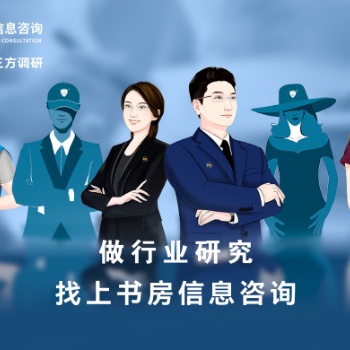本文由上書房信息咨詢(深圳第三方咨詢公司)出品,歡迎轉載,請注明出處。中國獨立第三方調研機構南寧市場調查公司上書房信息咨詢與深圳、廣州、珠海、惠州等各個地區的**及下屬單位均有長期的合作,涉及城市環境、文明、**政策、安全指標等各項調研,調研方面多樣,調研手段豐富,通過對不同城市的調研,建立完善了一系列評估體系,并實用于各個調研中。
行業研究涉及多種方法和技術,以下是一些常用的行業研究方法:
1、文獻研究:通過查閱行業相關的學術論文、行業報告、市場調研報告和專業出版物等文獻資料,獲取關于行業發展趨勢、技術創新和市場動態的信息。
2、數據分析:收集和分析行業相關的數據,如市場數據、銷售數據、生產數據和財務數據等。利用統計分析和數據建模的方法,揭示數據中的模式、趨勢和關聯性,以獲得深入的行業洞察。
3、市場調研:進行定量或定性的市場調研,通過問卷調查、深入訪談、焦點小組討論等方式,收集目標市場的需求、偏好、行為和態度等信息。市場調研可以幫助了解市場規模、競爭情況、消費者洞察和產品定位等方面。
4、競爭分析:研究競爭對手的市場地位、產品組合、定價策略、銷售渠道、市場份額和品牌聲譽等信息。競爭分析可以揭示競爭對手的優勢和劣勢,并為制定競爭策略提供依據。
5、技術研究:關注行業內的技術創新、研發活動和專利信息。通過追蹤技術趨勢、參與學術會議、與研發機構合作等方式,獲取關于行業技術前沿和創新方向的信息。
6、參觀考察:實地參觀行業企業、生產基地、研發中心或展覽會等,觀察生產過程、產品展示和行業趨勢等。參觀考察可以提供直觀的行業觀察和實地經驗,加深對行業現狀和發展的理解。
7、行業專家咨詢:與行業內的專家、從業者或顧問進行交流和咨詢,獲取他們的意見、見解和專業知識。專家咨詢可以提供深入的行業洞察和經驗分享,幫助理解行業的關鍵問題和挑戰。
8、SWOT分析:進行SWOT(優勢、劣勢、機會和威脅)分析,評估行業的競爭力和可持續發展的潛力。SWOT分析有助于識別行業的優勢、劣勢、市場機會和潛在威脅。
這些研究方法可以單獨或結合使用,以收集關于行業的全面信息和洞察,實現明智的決策和戰略規劃。
深圳第三方的市場調查公司上書房信息咨詢在2022年服務客戶超過100家,包含了寫字樓、產業園區、住宅、上海第三方滿意度測評、景區滿意度調查、滿意度調查問卷、深圳公眾民意調研、消費者滿意度研究、深圳地鐵廣告效果評估、開展購物滿意度調查、開展購物市場調查、滿意度調查報告、第三方評估市場調查公司、第三方評估市場調研、第三方評估市場調研機構、成都市場調查、上海小區業主滿意度調查等多種類型,調查項目覆蓋了國內160余個城市,通過電話調查、網絡問卷、現場訪問、深度訪談、焦點小組等方式調研有效樣本超5,000,000個。
Industry research methods
Industry research involves various methods and techniques. Here are some commonly used industry research methods:
1、Desk Research: Conducting extensive literature reviews and analyzing existing industry reports, market research studies, industry publications, and academic papers to gather information on industry trends, technological advancements, and market dynamics.
2、D**nalysis: Collecting and analyzing industry-related data such as market data, sales data, production data, and financial data. Statistical analysis and data modeling techniques are applied to uncover patterns, trends, and correlations within the data, providing in-depth industry insights.
3、Market Surveys: Conducting quantitative or qualitative market surveys to collect information on market demand, preferences, behaviors, and attitudes. Methods such as questionnaires, interviews, and focus group discussions are employed to gather insights into market size, competition, consumer preferences, and product positioning.
4、Competitive Analysis: Studying competitors" market positions, product portfolios, pricing strategies, distribution channels, market share, and brand reputation. Competitive analysis helps identify competitors" strengths and weaknesses, enabling the formulation of effective competitive strategies.
5、Technological Research: Monitoring technological advancements, research activities, and patent information within the industry. Tracking technology trends, participating in academic conferences, and collaborating with research institutions provide insights into industry innovations and emerging technologies.
6、Site Visits: Visiting industry companies, production facilities, research centers, or trade shows to observe production processes, product displays, and industry trends. Site visits provide firsthand industry observations and experiences, deepening un**nding of the industry"s current status and development.
7、Industry Expert Consultation: Consulting and exchanging insights with industry experts, practitioners, or consultants to gain their opinions, expertise, and industry knowledge. Expert consultations provide valuable industry insights and knowledge sharing, helping un**nd key industry issues and challenges.
8、SWOT Analysis: Conducting a SWOT (Strengths, Weaknesses, Opportunities, and Threats) analysis to assess the industry"s competitiveness and potential for sustainable development. SWOT analysis helps identify industry strengths, weaknesses, market opportunities, and potential threats.
These research methods can be used individually or in combination to gather comprehensive information and insights about the industry, enabling informed decision-making an**tegic planning.
|

